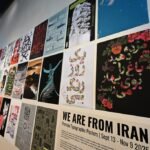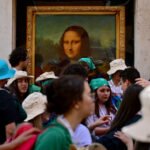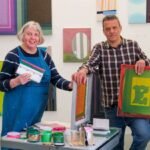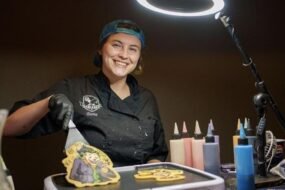
Art is everywhere in the cozy Myers Park home of conceptual artist Mariann Bernice Kearsley.
There are large statues she made inspired by women and goddesses from world history. Several wooden, painted walking figures patterned after ancient petroglyphs dot the shelves. Her painted portraits of friends hang everywhere.
Look up, and her assemblage of sticks, plastic bottles, and other found objects titled “Fake Plant Plague” looms over the dining table. An original creation by famed feminist artist Judy Chicago, whom Kearsley worked with in New Mexico, is on her bedroom wall.
These days, though, Kearsley, 76, can barely see any of it.
“I have central vision loss, I am blind in the center of my retinas,” Kearsley said matter-of-factly as she sipped a glass of water. “Nobody knows what it is for sure. I have been to so many doctors, I have had so many different diagnoses. So, I quit going to doctors.”
She also stopped driving automobiles long ago. Can’t read handwriting. Has a voice-activated computer. A pal called while she talked, offering to take her shopping at the Community Co-op Market.
Despite the eyesight problems, she still makes art and is a member of The Artist League of the Big Bend.
A dark, self-portrait collage by Kearsley from the late 1980s is in the “Synergy 4.0” annual summer group show by the Artists’ League at Tallahassee State College through Aug. 30. Next month, the exhibition moves to Jefferson Arts Gallery in Monticello with a public opening on Sept. 7. Other artists in the “Synergy” show are painter Barbara Psimas, potter-ceramist Mary Donahue, sculptor Mark Georgiades and more.
“I am not a joiner, but The Artists’ League is different,” Kearsley said. “It’s not about competition. It’s about making you a better artist.” The Artists’ League recently gave local artists $1,500 in cash and prizes. “That’s not bad for an organization our size,” Kearsley added.
Life-changing, European roots
Because her father was in the Air Force, Kearsley calls herself “a military brat” who grew up near bases in Italy and Germany.
“When I was 6, he took us to Dachau (a German extermination camp during World War II),” Kearsley said. “At 6 years old, I saw these ovens where they burned up people. … I saw the gas chambers, which were made to look like a roomful of showers. They told them (the imprisoned) that they were going to get a shower. They gave them granite; it wasn’t really soap. I saw those things. People would go in there, and they would gas them. It was hideous.”
The visit to Dachau in the early 1950s would profoundly impact Kearsley’s life and art. “It has informed my life; I can’t be racist,” she added. “I could see where it goes. I saw where it ends.”
Her father, who survived combat in WWII, was a Mormon who married a Catholic woman. The two raised Kearsley as Catholic. They also took her on trips to castles, cathedrals, and churches in Europe.
“They thought they were giving me a religious education, and it turns out they were really giving me an art education,” she said and laughed.
Flash forward a few years. Kearsley worked as a child-care foster parent for a Catholic home in Minnesota. The children lived on a measly $8 a month from the church. When a priest gave her and the kids a Sunday sermon on embracing poverty while wearing a hefty diamond ring, that is when Kearsley left the Catholic faith behind.
Humanitarian perspective on visual art
By 1978, Kearsley, who had previously studied anthropology, and seven roomies were living in a large house on Mission Road in Tallahassee. She had moved south to gain a master’s degree in social work at Florida State University and found a job as a clinical social worker. Then the art bug bit hard, and she went to FSU’s art school. “I’m a late bloomer, and I’m happy about it,” she said.
“With her knowledge, insight, and work ethic, she unknowingly became a role model for many of her fellow FSU female students,” said noted painter and FSU art professor emeritus Mark Messersmith. “She always had a brave artistic vision.”
Kearsley’s bravery came close to collapsing when the eye condition got her down. Her in-house art studio went dormant. Until she changed her mind. Now, visitors to her house are met by a tall table that takes up the front living room by the entrance.
The table is cluttered with her latest art project (titled “Hope Scotch,” a variation on the game of hopscotch). Players roll dice to receive a gender category, skin color, looks, etc. It is literally a game of life as chance. “This way, I am confronted with my art every day,” Kearsley said. “It’s always right there in front of me.”
If you go
What: “Synergy 4.5” art show by The Artists’ League of The Big Bend
When: Sept. 7 – Oct. 5. Opening reception Sept. 7 from noon to 4 p.m. Regular hours are Wednesday through Saturday, 10 a.m. to 2 p.m.
Where: Jefferson Arts Gallery, 575 W. Washington St. in downtown Monticello
Cost: Free
Contact: jeffersonartsgallery.com or call 850-997-3311
Mark Hinson is a guest feature writer for the Council on Culture & Arts. COCA is the capital area’s umbrella agency for arts and culture (tallahasseearts.org)











